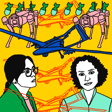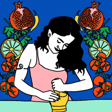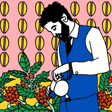Become a Creator today!Start creating today - Share your story with the world!
Start for free
00:00:00
00:00:01

2.9 An A-Z of food names with Salma Serry
Have you ever thought about the names behind the dishes you’re eating? Salma Serry, an Egyptian born filmmaker and interdisciplinary foodways researcher, gave us the lowdown on how many of the foods we know and love came to be named. We discuss folk tales, personal and national histories, and even get into the grammar of it all!
This episode also features contributions from Mahmoud Arif, Iran Seyed Raeesi, Rusaila Bazlamit, Rawand Issa, Rajae Oujlakh and Sergen Bahceci. Thank you for sending in your recordings!
Transcript
Introduction to Egyptian Bread Pudding
00:00:00
Speaker
I gotta say it's O'Malley. The dessert itself, O'Malley, is a bread pudding. It uses a type of a very flaky bread, a bread that is traditional in Egypt and was there since very early medieval times. I mean, I love the dramatic
00:00:18
Speaker
obsession, you know, with the whole jealousy, love triangle and the femme fatale figure. And it really ends up with this bloody story, more bloody legend, really. Hi,
Listeners' Regional Food Stories
00:00:39
Speaker
and welcome to episode nine of Incent Coffee. First of all, we want to thank you for your responses to our call out for this episode.
00:00:46
Speaker
It was great to chat to you all and to hear your wonderful memories and stories of dishes from your regions. And we're excited to be able to include them, so keep an ear out for your stories dotted throughout our conversation.
00:00:57
Speaker
So, Natine, I have a story about a food name that I wanted to share with you. I don't think I've said it to you before. Okay, go for
Laban Emmou: His Mother's Milk
00:01:03
Speaker
it. So, the dish is called laban emmou. Have you tried it before? I haven't, no. Okay, so let me try to explain it to you. It's basically a stew of tangy yogurt with pieces of meat in it. And laban emmou in Arabic translates to his mother's milk.
00:01:23
Speaker
which basically it's a very it's quite a it's quite a gruesome story it's not really a story but a name and that's because it's pieces of me of a calf that's basically swimming in the milk of his mother i love this recipe actually it's one of my favorite recipes but then when i heard the name it kind of made me feel a bit sick right well on that note let's move to introducing our guest salma sari
Salma Sari's Passion for Food
00:01:52
Speaker
Salma is a food researcher and filmmaker. She is founder of Sofra Kitchen and her story with food started very early on in her childhood. My story with food really starts pretty early and I remember just recently I was an man looking for some old cookbooks and I was in a warehouse of some old library bookstore that used to be there. Sadly it's not but the owner
00:02:21
Speaker
was kind enough to let us into the warehouse and try to hunt down old vintage books and stuff. So I stumbled upon this cookbook and it looked really familiar. It was from 1996 and I looked through it and I realized that that was my very first cookbook that I had when I was almost eight years old and I never realized that I had a cookbook when I was that young. But I do remember growing this really close, just liking to
00:02:51
Speaker
food stories and why we eat certain things and how they became to be, how they're different from one house to another in my family. And slowly, you know, when I was growing up doing my studies at mass communication and film, I realized that I'm just attracted to covering more stories and doing more narrative films even that have food as a very central element to it.
00:03:18
Speaker
A
Founding Sufra Kitchen: Documenting Food Culture
00:03:19
Speaker
couple of years ago, Selma started doing more in-depth research into the history of food. She had realized the massive need to document and archive the rich culture and history of food and food ways in the Swana region. And this is where Sufra Kitchen was born.
00:03:32
Speaker
I grew up eating foods and dishes from all over the world, really. And my idea of a national cuisine was really questioned and kind of challenged very early on. And I realized that really the richness lies in how food is connected and how it connects us to each other. And so I suppose Sufra as a project, Sufra Kitchen,
00:04:00
Speaker
on Instagram was born out of the need to really look into these connections and ask questions but also share information as a researcher and try to document and archive as much as possible.
Arabic Verbs and Food Preparation
00:04:15
Speaker
Utilising the Arabic dictionary is another important research method for Salma. Sometimes the root of a food's name is actually linked to a verb, helping us understand how a dish is prepared or describing the main technique used to create the food.
00:04:29
Speaker
like theraḍa, the verb theraḍa, to break or break into little pieces or really crush became used as the root verb for the dṛṣ tārīd. Tārīd is very popular within the Arabic and the Bedouin cultures.
00:04:49
Speaker
in the Arabian Peninsula but also in parts of North Africa. We've got the verb kamara which means to cover and from there the dish makmur became came to be and the verb samata
00:05:05
Speaker
is so interesting. Sammoto means to dip in boiling water and in the dictionary it gives an example of how you dip a fresh cutlet of meat to just really sanitize it and then the word or the name the the dish samit the the baked Turkish samit is very interesting in how
00:05:30
Speaker
to make some meat and the specific technique is required is to dip the the piece of dough into boiling water before you bake it. And this is really interesting in how
00:05:44
Speaker
Even the word that, I mean, we associate Samit now as something that is Turkish and not necessarily Arabic, but the fact that the name of the dish itself has roots in Arabic language, an Arabic verb that is so specific to its technique really, you know, raises some questions. Dishes were also named according to what they looked like or how they were presented.
00:06:07
Speaker
like the muhluba, for instance, or the muhluta, mabruma, these were all medieval dishes. And some of them were really poetic, like one of them is called Nergessiya, named after in reference to the daffodil flower, because it's essentially a dish of sunny side up eggs that look like the yellow heart of the flower.
00:06:30
Speaker
really pretty and they also tell us of the origins of the word of the origin of the of the dish like some medieval dishes called chirazilla or jalabilla and of course there were a lot of people who decided to name dishes after themselves or there were dishes that were named after them so we've got the famous mujalabilla for instance mujalabilla is the pudding rice pudding or a starch pudding
00:06:56
Speaker
And it was named after Muhallab ibn Abi Sufrah, who was an Umayyad general and the governor of Iraq, I believe. And there was a name, a dish that was named specifically after Haruna Rashid, called Haruneya, which was a stew. And his half-brother, who was
00:07:16
Speaker
A massive gourmand was called Ibrahim al-Mahdi. And Ibrahim al-Mahdi had his own version of a stew called Ibrahimiyyah, also that was mentioned in medieval cookbooks. The
The Royal Roots of Mulukhiya
00:07:30
Speaker
first story we wanted to share was sent to us by Mahmoud Aarif. He tells us about his love of Muhriyeh, a dish made from chute leaves. And the Levant is prepared with shredded chicken and served over rice.
00:07:43
Speaker
And in Egypt, it's more like a soupy consistency and served with bread. My mom loves making ulukeya, but whenever we get non-Egyptian guests come over and they're shocked at this green soup, my dad needs to tell them that this dish was actually named ulukeya, which means royalty. And the story behind this is that during the Fatimid era in Egypt,
00:08:03
Speaker
There was a ruler named Umar Azliddi Linda, and he was unwell once, and then this doctor prescribed Melukiah for him, and he got better. So he decided, okay, this works. I can't have the public consume this. So he decided to rename it Melukiah and decided the only royalty can grow and can consume Melukiah.
00:08:25
Speaker
This stayed on until the next ruler, al-Hakim al-Famri Allah, and the story is that he had milukhayya served to him, but then the chef accidentally poured it on his feet and it burnt him. So he's like, that's it. The public can have milukhayya. It's not milukhayya anymore.
00:08:44
Speaker
Iran's Syed Raisi, an LSE alumna, sent us the story behind Mirza Ghosemi, a famous dish from the region of Gilan where she is from. Iran also told us that in 2015, RASH, the capital city of the province of Gilan, was also recognized as a creative city of gastronomy by UNESCO. Mirza Ghosemi. It's a dish from Gilan, in the north of Iran and on the coast of the Caspian Sea.
00:09:13
Speaker
Mirza Hasemi is made with eggplants, tomatoes, eggs, and garlic. Generally speaking, Iranian dishes which are named after people are only a hundred or so years old. And Mirza Hasemi is no exception. Mirza was a noble title for men in Iran.
00:09:35
Speaker
And Gosem, or Gosemi, meaning of Gosem, is a name for men. The dish is indeed named after the man who came up with it, Mohammad Gosem Khan. Around 1860, following appointments in the Russian Empire, Mohammad Gosem Khan was appointed by Nauseel Din Shahi Rajar as the governor of Gilan.
00:10:00
Speaker
He is thought to be very fond of cooking, and often experimented with different ingredients in his kitchen. One of his experiments gave us Mirza Rossémi, a dish that Guillain is famous for. It is thought that the dish's popularity, beyond its delicious taste, is due to its affordability, fast cooking and wholesomeness, much needed at the time as there were periods of food shortage.
00:10:30
Speaker
Rusayla
Sage in Palestinian Lore
00:10:31
Speaker
Baslamit is an academic based in Melbourne. She is also a baker and runs a blog called Tabun Bakery. She tells us the Palestinian story behind the name of Sage in Arabic or Maramilla. So my Palestinian grandmother used to tell us the origin of the naming for Sage and Sage is one of the most popular herbs used in Palestine and in Jordan. So Sage in Arabic is called Maramilla.
00:10:58
Speaker
or sometimes in Palestine they call it Maria Mia. And that is in relation to Sitna Maria or Virgin Mary. And it is believed that this plant has sprouted after Virgin Mary gave birth. And the plant or the herb sage, Maria Mia, was meant to help with her pain after giving birth.
00:11:28
Speaker
And since then, Palestinians in Jordan as well, they use Maramiya, women use Maramiya when they are on their monthly cycle and it is meant to help with the pain that they are feeling. So we've got all these names and feel-good stories and a lot of this information has been passed down orally with very little written evidence. So is anything actually grounded in reality?
00:11:55
Speaker
And more importantly, does it even matter? So sometimes as a researcher, I look back and try to see if these stories are supported by facts, things that have been recorded or mentioned in history, whether in literature,
00:12:11
Speaker
in historians' accounts, in, you know, travellers' accounts, geographers, sometimes you find the most random places, you find these stories in the most random places in history. But oftentimes,
Origins of Hara Asbal
00:12:27
Speaker
and most of the time, imagination really has a lot to do. One example of a dish name based on a folk story is Hara Aspal, which translates to burnt fingers.
00:12:39
Speaker
It is a traditional stew from the Levant, cooked differently depending on the region. Rawan Daisa told us a couple of stories she's heard about the origin of the name. Hara asbaw is a dish described as farmer's food or poor people food because its main ingredients are bread and lentils.
00:13:05
Speaker
I know that people from Iqneem al Kharu and from South Lebanon more generally cook it. I don't know if other regions also have a variation of the dish. There are two stories behind the name. The first said that because women spent so long stirring it, they burned their fingers.
00:13:25
Speaker
Another story goes that once a man went into the kitchen to see what his wife was preparing, but she wasn't there. So he opened the pot and tried to taste it, but burnt his finger. And this is where a burnt finger comes from. Another dish that carries centuries of history in its name is China, a Moroccan Jewish Shabbat recipe. My name is Raja and I'm from McNas, Morocco. My city used to host a large Jewish community in two Jewish neighborhoods known as the Old and New Melah.
00:13:54
Speaker
My mom was exposed to the Jewish tradition through her friend and a haute couture teacher, Madame Regine. She used to tell me stories about how Madame Regine was keen on preserving Moroccan Jewish traditions. One of those traditions is the Shabbat dish, Shena. The name Shena comes from an Arabic word which means heart.
00:14:13
Speaker
This traditional dish and the way it is prepared makes it possible to be eaten still hot without having to violate the ban on lighting fire on Shabbat. It is prepared on Friday afternoon, it cooks overnight from Friday to Saturday, and is eaten for lunch on Saturday. Friday used to be a day of grand labor in Jewish households. The women wake up at sunrise to make all the preparations for Shabbat. They bake bread for two days.
00:14:39
Speaker
clean and tidy up the house, then they prepare all of the meals for Saturday. They start making Srena around noon. The dish is basically made of eggs, potatoes, rice, chickpeas and meat. Depending on circumstances and the number of guests, one or more ingredients is added. On festive occasions, stuffed chicken, dates, cow's feet and tongue are added. And following
00:15:03
Speaker
The Moroccan tradition of mixing sweet and sour, two types of stuffing are added. The sweet stuffing is made of sweet potatoes, almonds, and dried raisins. The savory stuffing is made of rice and minced meat.
00:15:16
Speaker
The dish is seasoned using herbs and spices such as parsley, cinnamon, cloves and nutmeg. Women used to prepare it in earthenware pots which were hermetically sealed and then cooked over a very low flame at home or at the neighborhood baker's oven.
00:15:33
Speaker
where it cooks over tiny pieces of coal that are close to extinguishing, making the cooking process slow. Emperation hardly changed since the old days, only the cooking mode changed. At least at the time when my mom's friend lived in Mcness, China was of great symbolic value to the Moroccan Jewish community. Women put all their culinary talents into it and the result was an exquisite mixture of flavors, perfumes and colors.
00:16:00
Speaker
It's not just the dish names, but also, you know, ingredients, you know, and myths and folk stories have a lot to do with it. Taking eggplant, for example. So with the word Bevanjan, a lot of people associate it with Bayd Aljan, the egg of Jin. And when I try to look into its history and etymology, a little bit of its origin,
00:16:30
Speaker
It turns out that the word Badenjan in Arabic originally has its root in Sanskrit, Indian, and the word is vatind gana. Vatind comes from wind, gana comes from expelling because of its medicinal properties of expelling wind in the body.
00:16:53
Speaker
So in reality, the word has nothing to do with bade or gin or even the folk beliefs that have been documented in 19th century that I came across in Egypt, where there was a belief that eating eggplants during the summer season, which is the season of eggplants, promotes madness and hallucinations.
00:17:17
Speaker
And it's not far off from the misconceptions about eggplant that was new to Europe in the 15th and 14th century, where it was also thought to induce hallucinations and madness, so an irrational behavior. So really, eggplant is just the perfect example of this movement of myths and culture and language, and it's all in the food name.
00:17:45
Speaker
Some talk
Cultural Exchanges Through Food Names
00:17:46
Speaker
to us about a boomerang effect. Just like a boomerang, recipes travel across the world from the Middle East. They are integrated into local cuisines and languages and their names change.
00:17:57
Speaker
When they find their way back to the region, they return as an updated version of the original dish. So the word Badanjan was borrowed or has roots in the ancient Sanskrit and it traveled to Persia and from Persia to the Arab world. And then the Arabs through ways of trade and also colonization of Spain, the Iberian Peninsula. The word Badanjan became el,
00:18:26
Speaker
and from there became aubergine, which is the French word for that. And we've got the Spanish word, I believe, I'm not sure how to pronounce it, but it's very close to Beringel, which is also very close to Beringel. And Beringel, then from Spanish and the very close, Brinjel in Portuguese, was moved back
00:18:53
Speaker
when Portugal colonized parts of India and then it became known there as Brinjell and not Vattenjana, the original Sanskrit word. So it's really again this huge massive boomerang effect in this case again.
00:19:10
Speaker
back and forth movement of words and the changes that happen in between is just really something so interesting to me and the relationship of language in general to food. So an example that caught my attention was how Rahat al-Halkum or Turkish Slukam was named initially
00:19:33
Speaker
in Arabic which means the comfort of the throat. It was named so because of its medicinal purposes. It was something that really relieves the throat and the digestive system after eating. And it was after the Ottoman rule here in the region that the word rahat al-halqum in Arabic
00:19:56
Speaker
became Turkified and changed into locum from hulkum. Now it's known all around the world as Turkish locums. Even here, where we speak Arabic, a lot of people know it as locum and not rahat al hulkum. What became clear from our conversation with Salama is that learning about the history of food breaks down rigid nationalistic claims to dishes.
00:20:21
Speaker
These stories and histories reveal an intertwined relationship of people from different ethnicities and cultures who came into contact with one another through trade, war or even the Hajj pilgrimage.
00:20:32
Speaker
So Khushri, I was so surprised to see it just a couple of weeks ago in an old cookbook from Iraq in the 1960s, and it was mentioned as Khushri, right? And it's immediately linked to what I know of
00:20:52
Speaker
the Kijri in Afghanistan and India as well, which is it does not use lentils but beans with rice. India also with the British mandate, Egypt at the time also had it through that because it was not mentioned or I was not able to find any
00:21:14
Speaker
sources that mention Qushri before that, before, you know, early 20th century. There are some references, though, for late, like before earlier, but it links it to the Hejaz, also the Hejaz area. So the movement of the Hej is also another theory, the movement of Egyptians and Hashem. Maybe they met there with the, they encountered the Indian Qichri.
00:21:43
Speaker
So that's another theory. It's really interesting in how, you know, we think, we hold so hard to this notion of national cuisines that it just belongs to us, or it just belongs to one nation or one society when history really proves end language, history and language prove otherwise.
Cleftigo: A Cypriot Lamb Roast
00:22:04
Speaker
Sergin Bacheci sent us a story about Gleftiko, which is popular in Cyprus among both Greek and Turkish Cypriots.
00:22:11
Speaker
Sergin is a PhD candidate of anthropology at LSE, and he has been doing fieldwork in a Cyprus, discovering a number of food stories that bring up the history and politics of the country. So Gléftigo is a lamb roast that is cooked in large clay ovens over I think about eight, nine hours. It is usually served along with potatoes and rice, and it is usually cooked for special occasions or consumed with the extended family over the weekends. And it is mostly done in villages.
00:22:39
Speaker
In Cyprus, the dish is popular among both Turkish and Greek Cypriots, and I think the word kleftego means stolen meat in Greek. This is because I think the dish is believed to have been popular among herd traders who would steal a lamb or sheep and cook it in a large pit in the ground overnight in order to avoid being seen by others. I think the Greek name also refers to the klefs, who fought against the Ottoman Empire in Greece and Crete.
00:23:07
Speaker
Turkish Cypriots refer to it as cleftigo as well, but it is also called oven kebab or juicy kebab because the meat is usually quite juicy when it comes out of the oven. Finally,
Omali Dessert's Dramatic History
00:23:21
Speaker
we had to ask Salma about her favourite food story and the famous Omali, who a lot of you had mentioned, came up. I mean, I love the dramatic
00:23:31
Speaker
obsession, you know, with the whole jealousy, love triangle and the femme fatale figure and it really ends up with this bloody story, more bloody legend really. But it's just, you know, it reflects so much about how we as an Egyptians just love
00:23:53
Speaker
drama. So it's really, for those who don't know, it all takes place in the 13th century and the dessert itself, Amali, is a bread pudding. It uses a type of a very flaky bread that is traditional in Egypt and was there since very early medieval times. And then it's cooked in the oven with milk
00:24:17
Speaker
and cream and nuts and drizzled with some honey on top if you like and it's really really delicious and it's really ubiquitous in all celebrations until this day.
00:24:28
Speaker
But the legend has it that Shajar al-Dur, a sultan of the last Ayyubid times, who was actually the wife of the Ayyubid sultan of Salah Ayyub, the last of the Ayyubid sultans actually. She got remarried after his death to a certain Aziddin Ayyebak, who in this case was the first of the Mamluks sultans.
00:24:56
Speaker
and she got really jealous when he himself got remarried and legend has it that she plotted to kill him and he died and so as a Dean Abecs the deceased first wife
00:25:14
Speaker
got extremely mad that her husband got killed by Shajar Adur and she really plotted revenge on her life and she just took her life away and killed Shajar Adur
00:25:29
Speaker
And that's one story or one variation of the story. There's so many, of course, as, as, you know, the different complicated marriages allows. And so because she was, um, Ali is the first wife of Azzedine, I back who died. She got so happy that, you know, she was killed and, uh,
00:25:48
Speaker
She decided to, you know, give out and open up her kitchens to all the public and give out this dessert and celebration of the death of Shajar Adur, the evil femme fatale. Thank you for tuning into Instant Coffee, the podcast brought to you by the LSE Middle East Center.
00:26:11
Speaker
and produced by me, Dibha Salmaan Hayda, and me, Nadine Almanasvi. We'd like to thank Mahmoud, Iran, Ruseyla, Rwanda, Raja, and Sargent for sending their stories in. We were pleasantly surprised to see that people from all over the place, Melbourne to Istanbul and Mechnis, followed our podcast. To learn more about Salmaa's work, follow the links in the podcast description. We'll be back in two weeks for our tenth and final episode of this season's instant coffee, so you don't want to miss it.



















